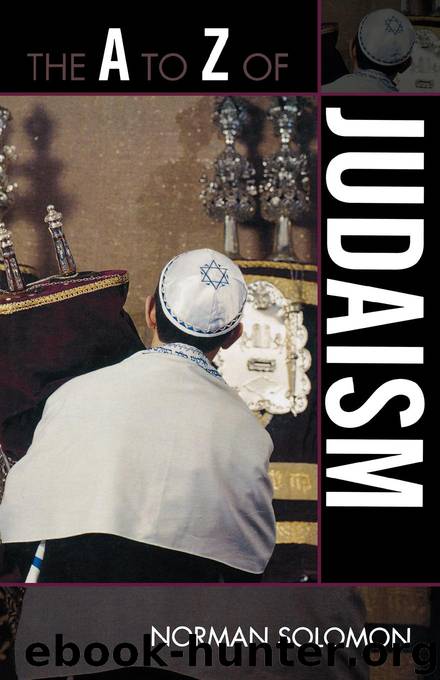The A to Z of Judaism by Norman Solomon

Author:Norman Solomon
Language: eng
Format: epub
Publisher: Scarecrow Press
Published: 2006-06-12T16:00:00+00:00
- M -
MACCABEE. See FAITH AND REASON; HANUKA; ḤASID; JOSIPPON; SADDUCEES; Table 19. Judah the Maccabee led the Jewish revolt against the Seleucids in 168 BCE. The origin of the designation “Maccabee” is unknown; it was applied loosely to the HASMONEAN dynasty as a whole.
MAGIC. Various kinds of magic, witchcraft, and sorcery are explicitly forbidden by the TORAH (Ex 22:17; Lev 19:26, 31; Deut 18:10, 11; M66, 244, 245, 260, 261, 510-515), though instances of such practices occur (1 Sam 28; Is 47:9, 12), and it is evident that they remained part of popular Israelite culture.
J. A. Montgomery, in 1913, published a volume of Aramaic Incantation Texts from Nippur, and since that time numerous HEBREW and ARAMAIC AMULETS and incantation bowls from the first to eighth centuries have been recovered and studied by archaeologists. Some were written by non-Jews evidently aspiring to capture the efficacy of “Jewish magic,” which was held in high repute in late antiquity, and which had been specially cultivated by the Jews of Alexandria; but recent discoveries demonstrate the prevalence of Jewish magic in Iraq and Iran.
The Babylonian TALMUD is somewhat ambivalent. Contact with Magi, who were priests of the dominant religion in Sasanian Babylonia, was frowned upon (B Shab 75a), and the biblical strictures on magic were upheld in principle, yet numerous instances are recorded of rabbis recommending spells and other apparently magical procedures for the cure of various ailments (B Shab 66b), or demonstrating magical techniques such as the ability to fill a field with cucumbers (B Sanh 68a).
A substantial Jewish magical literature emerged in the Middle Ages in circles such as those of the ḤASIDEI ASHKENAZ; it is not always easy to distinguish magic from practical KABBALA, which escaped the biblical strictures since it was mainly concerned with permutations of the letters of scripture and the names of GOD. Moreover, belief in the efficacy of magic and in alleged phenomena such as DEMONS, possession, and the evil eye, was almost universal in the premodern world and persists in popular culture; only MAIMONIDES, among the leading medieval Jewish thinkers, denied the reality of such phenomena. The play The Dybbuk by the Yiddish writer S. Ansky (1863-1920), and the novels of Isaac Bashevis Singer (1904-1991), convey something of the vividness with which people until very recently imagined themselves surrounded by invisible beings and forces which controlled or at least influenced our destinies.
B320-Trachtenberg; Zimmels.
See also BAAL SHEM TOV; SUPERSTITION.
MAHARAL OF PRAGUE (c1525-1609). Judah Loew ben Bezalel is more commonly known as Der Hohe Rabbi Loew, or from his Hebrew acronym as Maharal. Renowned for his piety and ASCETICISM, he was one of the outstanding leaders of Central European Jewry in the 16th century. From 1553 to 1573 he was Landesrabbiner (chief rabbi) of Moravia and from there went to Prague where he founded a YESHIVA (the Klaus), organized circles for study of the MISHNA, and engaged in communal affairs. Despite substantial intervals in Poznan, Poland, where at one time he was chief rabbi, most of the rest of his life was spent in Prague, where he eventually became chief rabbi.
Download
This site does not store any files on its server. We only index and link to content provided by other sites. Please contact the content providers to delete copyright contents if any and email us, we'll remove relevant links or contents immediately.
| Buddhism | Christianity |
| Ethnic & Tribal | General |
| Hinduism | Islam |
| Judaism | New Age, Mythology & Occult |
| Religion, Politics & State |
Cecilia; Or, Memoirs of an Heiress — Volume 1 by Fanny Burney(31331)
Cecilia; Or, Memoirs of an Heiress — Volume 3 by Fanny Burney(30933)
Cecilia; Or, Memoirs of an Heiress — Volume 2 by Fanny Burney(30889)
The Secret History by Donna Tartt(16618)
Sapiens: A Brief History of Humankind by Yuval Noah Harari(13047)
Leonardo da Vinci by Walter Isaacson(11901)
The Radium Girls by Kate Moore(10906)
Sapiens by Yuval Noah Harari(4534)
The Wind in My Hair by Masih Alinejad(4424)
How Democracies Die by Steven Levitsky & Daniel Ziblatt(4397)
Homo Deus: A Brief History of Tomorrow by Yuval Noah Harari(4276)
Endurance: Shackleton's Incredible Voyage by Alfred Lansing(3839)
The Silk Roads by Peter Frankopan(3758)
Man's Search for Meaning by Viktor Frankl(3630)
Millionaire: The Philanderer, Gambler, and Duelist Who Invented Modern Finance by Janet Gleeson(3568)
The Rape of Nanking by Iris Chang(3514)
Hitler in Los Angeles by Steven J. Ross(3435)
The Motorcycle Diaries by Ernesto Che Guevara(3332)
Joan of Arc by Mary Gordon(3257)
